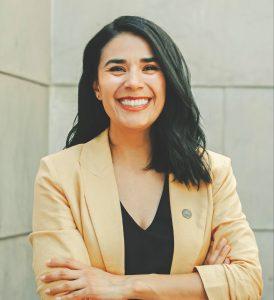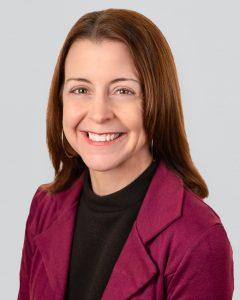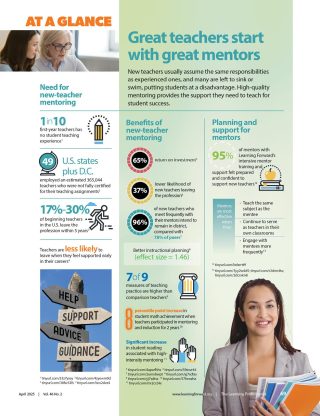IDEAS
‘It’s not about perfection; it’s about reflection’: Q&A with Juliana Urtubey
By Suzanne Bouffard
October 2024
 Juliana Urtubey, the 2021 National Teacher of the Year, is an advocate for a joyous and just education for all students. Trained as a bilingual special education teacher, she is now a program director at the Arizona K12 Center, a board member for the National Board for Professional Teaching Standards, and a member of President Biden’s Advisory Commission on Advancing Educational Equity, Excellence, and Economic Opportunity for Hispanics. Urtubey will be a keynote speaker on Dec. 9 at the Learning Forward 2024 Annual Conference in Aurora, Colorado.
Juliana Urtubey, the 2021 National Teacher of the Year, is an advocate for a joyous and just education for all students. Trained as a bilingual special education teacher, she is now a program director at the Arizona K12 Center, a board member for the National Board for Professional Teaching Standards, and a member of President Biden’s Advisory Commission on Advancing Educational Equity, Excellence, and Economic Opportunity for Hispanics. Urtubey will be a keynote speaker on Dec. 9 at the Learning Forward 2024 Annual Conference in Aurora, Colorado.
What is the joyous and just education framework about?
The joyous and just framework is about humanizing the process of building learning communities. It’s about developing spaces that are inclusive and celebratory of everyone’s identities and strengths. It is inspired by my experience as a classroom teacher and from co-constructing a school garden with our students, their families, and our staff, which taught me a lot of really important lessons.
In the framework, there are five promesas, or promises. They are essentially commitments that I, as an educator, make to my learning communities. These grow out of things my students have taught me. One of the promesas is recognizing brilliance. It encourages teachers to go deeper than acknowledging students’ assets to recognizing students’ brilliance. For example, I had a student who helped me understand that “English language learner” was a term that was much too small for her brilliance. She inspired me to launch the concept of students being linguistically gifted in recognition of the fact that our communities’ languages are essential and that multilingual learning is powerful.
The joyous and just framework is not just about students. Building the garden taught me a lot about learning from multiple generations, inviting family members to be meaningful parts of our community, and encouraging educators to look for the informal ways this can happen. So often, we invite families to come in and we talk about how to teach their children at home. But we miss opportunities to create trusting relationships where parents can recognize and unveil their strengths to us. Once we create informal ways to invite those skills and gifts into our schools and we have the mindset to recognize those skills, beautiful things can happen.
In these last two years, since my Teacher of the Year service year ended, I’ve been thinking a lot about how to move the teaching profession forward and about what a joyous and just system looks like for educators, schools, districts, and states. The framework is really about how to create a joyous and just system for us all.
How do joy and justice go together?
Joy is, for me, not only an end product or a destination, but a process. A commitment to that joy is intertwined with a commitment to justice because everyone in the community deserves to learn in joy — not just students, but also teachers and administrators and everyone else.
''A commitment to that joy is intertwined with a commitment to justice because everyone in the community deserves to learn in joy—not just students, but also teachers and administrators and everyone else.'' -Juliana Urtubey Share on XThe glue that holds joy and justice together is collective wellness. Collective wellness requires thinking about what everybody in your community needs to be well — including educators — and building healthy systems to address it. It means looking around your campus and asking: Who are the people who are not experiencing joy? Who are the people who are not experiencing justice? Why? And what can you do now with your school, team, and students to change that?
We all have opportunities to address joy and justice in our own realms of control. Teachers are responsible within our own context, not just for our students, but for colleagues. For example, what can we do to really invite new and early career teachers into the joy? And what can we do to give voice to policies and practices that help sustain and retain those teachers?
Administrators have a responsibility for joy and justice in their realms of control, too, and that means supporting their teachers. When I look at the data across districts and states in our country, we don’t see teacher attrition everywhere. We don’t see it in healthy, collaborative schools. In schools that have systems of support from a teacher’s first day on campus and have avenues for teacher voice and leadership, we’re not losing teachers. We have teachers who are happy and are staying because they sustain the work collectively.
In the last two years, I have been thinking and learning a lot about what a joyous and just education means not only for schools, but district and state systems. For example, administrators have some of the hardest jobs. We could have better systems to liberate their time to be more present in the instruction and culture of a school so that they can jump into classrooms and spend time. Often, one of the missing pieces is systems for teacher leadership. That can help cultivate joy and justice for teachers and for administrators.
It sounds like you are describing systems that acknowledge everyone’s strengths and needs. Do you think of this as an equity-centered framework?
The two elements of joy and justice are critical in bringing equity forward. I think equity is less of a paradigm and more of a mindset. It’s about asking the essential questions about what students need. And joy and justice provide entry points.
I don’t think anyone ever completely does equity work to complete perfection. There’s no such thing (as a perfectly equitable system). We constantly have new students, and what equity looks like for them is going to be different. We’re always learning and shifting, with changing students and changing resources.
That focus on process is important because you’ll see how quickly people shift out of the work when they focus on the fact that it’s not done. You’ll see how they become negative about the disparities and the scale of the work yet to do. I understand those challenges to be real, but progress is possible. I’m interested in seeing places where kids have a sense of liberation and autonomy in their learning, where they don’t feel like they have to dim down their languages, their histories, their families, to be able to have access to resources. Take me there to learn from those teachers.
Educators have told me that the joyous and just framework helps people who feel pushed away (from other equity efforts) because they’re not quite at a level of fully understanding what inclusive practices can look like. It gives them an entry point that is humbly humanizing students, families, and our overall practice. My framework shows them, “OK, I can do these things, and these things are equity. Let me dive deeper into them,” and they start to shift.
A lot of your current work focuses on teacher voice, leadership, and growth. How does professional learning support the development of teachers and the profession as a whole?
Part of the justice for educators is that we’re seen as experts in our work, and if we’re not experts, that we’re given the support to be able to become accomplished.
Professional learning has to be a journey, and it has to have the heartbeat of reflection through and through. I don’t care if it’s your first day in a classroom or your millionth — there is power in reflecting on your teaching and students’ learning. As a teacher, I have to de-center myself and center my students in what I’m learning. I have to connect what I’m learning to how it will change practice for my students. And that’s only possible through reflection.
This is something I focus on in my work with teacher residency programs. In these programs, new teachers do a full year of student teaching while they’re doing the first year of graduate studies, then a second year finishing graduate studies while teaching with an emergency certification, and then they are licensed teachers in year three.
The first-year teaching residents I work with do a lot of reflecting on how the teaching practices they’re learning about can look in the classroom. But when they talk about that with their supervising teachers, the reactions are mixed. Sometimes those conversations are very positive because the veteran teacher has the disposition that they can also learn from a beginning teacher.
But sometimes the residents come back to me feeling quite deflated because the supervising teacher doesn’t have that disposition or that willingness to deepen their practice. I’m helping the program develop how to work with supervising teachers and creating a parallel reflection process in which the experienced teacher is learning how to articulate their practice, analyze their decisions, review student learning, and reflect on next steps alongside the new teacher.
It has to be systematic. I know that we can’t expect it to just happen. And part of that is reiterating with the supervising teachers: What are our universal expectations of best practices? I see this in the National Board Certification. When teachers achieve their certification, the way they talk about their practice shifts because they understand they’ve gotten to the point of expertise by reflecting deeply on what their students need and where they need to go in their learning.
How do you foster reflection among new teachers?
One of the phrases that really resonates with the (novice) resident teachers I’ve taught is: It’s not about perfection; it’s about reflection. I tell them, “You don’t have to have this down perfectly by tomorrow. But what you do in the classroom tomorrow really matters, and you can make a decision to shift your practice bit by bit.”
In the induction and mentoring programs at the Arizona K12 Center, Kathleen Paulsen, assistant director of induction and mentoring, helps educators and mentors see that progress over time by encouraging mentors to give the new teacher a portfolio of their work together after finishing their first year. This (gesture) says, “Here are the goals you were working on and evidence of the way you talked about your practice. Look at how it shifted across the school year.”
We also share that progress. Kathleen runs the Arizona Induction Mentor Network. All the districts (in that network) come together twice a year, and we talk about the program with leaders from the districts. At the last network meeting, part of their work is to dive into the portfolios that the mentors have created, and they get to read, firsthand from the mentors, the things that are working, the growth, the celebration, and the human story of why the attrition rates are dropping. Our 2022 data showed that 87% of the teachers returned for year two, which is really great.
What message do you want to share with educators about professional learning and growth?
I think that in most professions, but especially education, we’re still in the habit of hiding our vulnerabilities. I’ve embraced my vulnerability as a strength. I believe that we need to name the barriers to equity and then find a collective way to be aware of them and understand how our practice clicks into that larger work. Professional learning is so important for teachers because it makes us realize that the puzzle piece we’re clicking in to this larger web is really essential. Now it’s time to own our vulnerabilities and plan for the future, but also bask in the ways that we are contributing to this future already.
Download pdf here.

Suzanne Bouffard is senior vice president of communications and publications at Learning Forward. She is the editor of The Learning Professional, Learning Forward’s flagship publication. She also contributes to the Learning Forward blog and webinars. With a background in child development, she has a passion for making research and best practices accessible to educators, policymakers, and families. She has written for many national publications including The New York Times and the Atlantic, and previously worked as a writer and researcher at the Harvard Graduate School of Education. She has a Ph.D. in developmental psychology from Duke University and a B.A. from Wesleyan University. She loves working with authors to help them develop their ideas and voices for publication.
Recent Issues
BUILDING BRIDGES
December 2024
Students benefit when educators bridge the continuum of professional...
CURRICULUM-BASED PROFESSIONAL LEARNING
October 2024
High-quality curriculum requires skilled educators to put it into...
LEARNING TO PIVOT
August 2024
Sometimes new information and situations call for major change. This issue...
GLOBAL PERSPECTIVES
June 2024
What does professional learning look like around the world? This issue...












